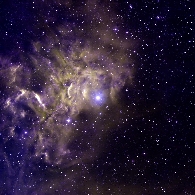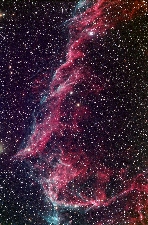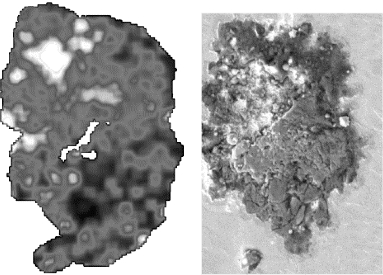

The Deuterium Puzzle Solved?
Astronomers Trace "Fossil" of Big Bang Across our Galaxy
(Click on figures to see larger versions.)
Based on the results reported in a paper by J. Linsky et al., The Astrophysical Journal, Volume 647, page 1106. Presentation courtesy of William Blair, JHU.
(A previous FUSE Science Summary describes the "deuterium puzzle" in more detail.)
The measurements are of deuterium, a "heavy" form
of the hydrogen atom that contains both a proton and a neutron in the
atomic nucleus. Astronomers believe that a set amount of deuterium
relative to regular hydrogen was created about 1000 seconds after the
Big Bang, and that no new deuterium has been created since then. Rather,
deuterium atoms have only been destroyed since that time by nuclear reactions in stars.
The more gas has been processed through stars, the lower the amount of deuterium that
should be observed today. At the same time that stars are destroying
deuterium, they are creating heavier elements through nuclear fusion.
Hence, the abundance of deuterium observed locally
in our Galaxy should provide a critical test of how the heavier elements
like carbon and oxygen have been formed over cosmic history.
But deuterium abundances have been notoriously difficult to determine
accurately. Before the launch of NASA's FUSE satellite in June 1999,
only a handful of measurements were available. Most of these agreed
with a fairly constant value for nearby regions of our Galaxy, but there were
a few outlying measurements that appeared to be either higher or lower, for reasons
that were not understood.
"For 35 years, the true amount of deuterium in our Galaxy has
remained a mystery because measurements of its abundance in the gas between
stars by instruments on several satellites have yielded conflicting results,"
said Dr. Jeffrey Linsky of JILA, a joint institute of the University of
Colorado and the National Institute of Standards and Technology in Boulder
Colorado, who led the analysis.
Caption: The deuterium-to-hydrogen ratio in "parts per million" (ppm) is plotted
versus distance to each observed star. The points to the left of the dashed line indicate
an essentially constant value for this ratio in the regions nearest the sun. However,
points to the right of the dashed line scatter up and down, indicating variations in the ratio at
larger distances.
(Graphic courtesy of George Sonneborn, using data from Linsky et al. 2006. Full reference
given above. Click image to enlarge.)
Measuring deuterium is one of the special capabilities of the FUSE satellite.
A major result from six years of FUSE observations is that
this variability in the amount of deuterium in interstellar gas is real.
Scientists have used hundreds of hours of FUSE observing time to measure
deuterium abundances in the gas toward dozens of stars, both near and far,
and have found a striking pattern.
"Gas near to us shows a nearly constant value of deuterium, but beyond the
local region values vary dramatically," said Warren Moos, professor at
Johns Hopkins and the FUSE principal investigator. "There's really no doubt
about it anymore."
But what could be causing these variations had left scientists stymied,
until now.
"Our analysis shows us that the very low gas phase abundances of deuterium
measured in many regions results from depletion of deuterium onto interstellar
dust grains where it cannot be detected," said Linsky. "In other regions that have been disturbed
by supernova explosions or radiation from hot stars, the dust grains can be
vaporized and deuterium is returned to the gas phase."
CLICK HERE for a figure that
demonstrates this effect graphically. (Graphic by Jeff Fal, JILA.)
Caption: (left) The star AE Aurigae is embedded in a region
of space containing smoke-like filaments of carbon-rich dust grains.
Over time, deuterium atoms can attach to the dust particles where they cannot be detected.
(Image credit: T.A. Rector and B.A. Wolpa, NOAO, AURA, and NSF. See
http://antwrp.gsfc.nasa.gov/apod/ap011204.html .)
(right) The graceful arcs of the Veil Nebula (Cygnus Loop) supernova remnant are seen against the rich
star field of the Milky Way. The passage of shock waves such as this through interstellar
space may play a key role in releasing deuterium atoms from interstellar dust grains
back into the gas phase of the interstellar medium.
(Image © Steve Mandel, Hidden Valley Observatory; used with permission. See also
http://antwrp.gsfc.nasa.gov/apod/ap010928.html .)
The theoretical underpinning of this result is largely due to Bruce Draine,
an astrophysicist at Princeton University. His computer modeling of dust
grains in interstellar space show how, in regions that remain undisturbed
for long periods, deuterium atoms systematically leave the gas phase
and replace normal hydrogen atoms in dust grains. This leads to low
observed values of deuterium in the gas. When a region is disturbed by
supernova shock waves or nearby hot stars, the dust grains are vaporized,
releasing the deuterium atoms back into the gas. This
explains the variations in gas phase deuterium observed with FUSE.
There is some direct observational underpinning of this concept as well. High flying
airplanes have managed to collect small samples of interstellar dust particles from
the very top of our atmosphere before they burn up. Laboratory studies of such
particles do indeed show significant increases of deuterium in comparison to
regular hydrogen.
Caption: The image at right shows interplanetary dust particle L2011 D11, which was captured
in the Earth's upper atmosphere by a NASA airplane. This scanning electron micrograph shows the
complex structure of these fragile particles, which can be partially or totally vaporized by
the passage of a supernova shock wave or by heating from a nearby hot star. At left is a
deuterium to hydrogen ratio map of the same particle, with white areas showing strongly
enhanced D/H ratios.
(Image from S. Messenger (2002), Planetary and Space Science, 50,
1221. Used with permission.)
The primordial deuterium concentration (that is, the amount created in the Big Bang)
as measured by
NASA's WMAP satellite
and other analyses, is about 27 parts per million
compared with regular hydrogen. The "local bubble," which surrounds our sun and is a few
hundred light-years across, has a gas phase deuterium concentration of only 15 parts per
million and some distant regions of interstellar space have measured values as low
as 5 parts per million. These are undisturbed regions where deuterium has had time to
condense into dust. In other places, FUSE finds concentrations as high as 23 parts per
million. These represent regions where disruptions have destroyed dust grains and released
deuterium atoms back into the gas phase of interstellar space.
"Assuming our interpretation of the FUSE data is correct, the high values of gas phase
deuterium are close to the real total deuterium abundance in our Galaxy," notes Moos.
These values are only 15% or so below the deuterium value thought to have arisen from the
Big Bang. Models of our Galaxy's chemical evolution to date have normally assumed a much lower
deuterium abundance, and thus much more processing of material through stars over
time than is indicated by the FUSE result. Alternatively, the infall of significant amounts
of primordial gas from outside the Galaxy (gas with relatively high deuterium abundance)
might have occurred in the past, with this material artificially raising the galactic deuterium
values. Either way, it is now clear that our understanding of the chemical evolution of
our Galaxy has been missing key information. Accounting for the FUSE result will
improve these models and lead to a better understanding of the chemical evolution of
our Galaxy and galaxies in general.
"This result has been a long time in the making," said George Sonneborn, NASA project
scientist for FUSE. "It is a testament to the determination and effort of the entire FUSE
team, and it is clearly a legacy of the mission."
Further reading:
Journal paper on this result:
Earlier paper that paved the way to this result:
NASA Support Site for
this Result
NASA press release on this result:
JHU press release on this result:
University of Colorado press release on this result:



"What is the Total Deuterium Abundance in the Local Galactic Disk?"
Linsky, J. L., Draine, B. T., Moos, H. W., Jenkins, E. B., Wood, B. E.,
Oliviera, C., Blair, W. P., Friedman, S. D., Knauth, D., Lehner, N.,
Redfield, S., Shull, J. M., Sonneborn, G., Williger, G. M., 2006, The Astrophysical
Journal, Vol. 647, page 1106.
"Two New Low Galactic D/H Measurements from the Far Ultraviolet Spectroscopic Explorer,"
Wood, B.E., Linsky, J.L., Hébrard, G., Williger, G.M., Moos, H.W., & Blair, W.P. 2004,
The Astrophysical Journal, Vol. 609, page 838.
NASA FUSE Satellite Solves the Case of the Missing Deuterium
"Hidden" Milky Way Deuterium Found
Surprising New Telescope
Observations Shake Up Galactic Formation Theories